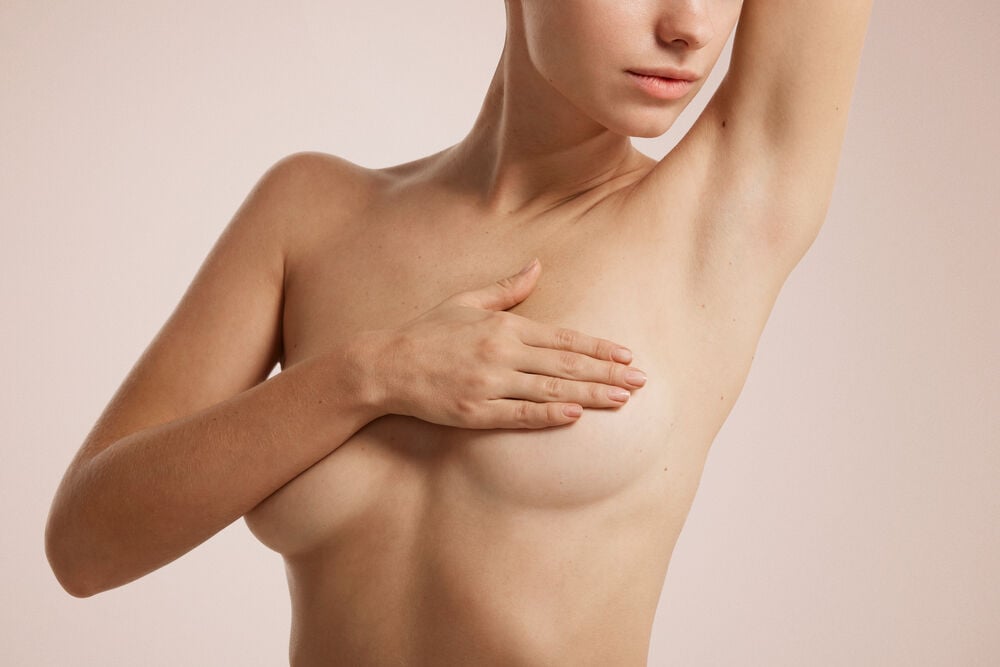Finding a lump in your breast can be very frightening, but not all lumps are breast cancer. Fibroadenomas are noncancerous lumps that develop in one or both breasts. They’re fairly common and can be successfully treated. Read on for more information about fibroadenoma breast lumps.
-
Tracking cycle
-
Getting pregnant
-
Pregnancy
-
Help Center
-
Flo for Partners
-
Anonymous Mode
-
Flo app reviews
-
Flo Premium New
-
Secret Chats New
-
Symptom Checker New
-
Your cycle
-
Health 360°
-
Getting pregnant
-
Pregnancy
-
Being a mom
-
LGBTQ+
-
Quizzes
-
Ovulation calculator
-
hCG calculator
-
Pregnancy test calculator
-
Menstrual cycle calculator
-
Period calculator
-
Implantation calculator
-
Pregnancy weeks to months calculator
-
Pregnancy due date calculator
-
IVF and FET due date calculator
-
Due date calculator by ultrasound
-
Medical Affairs
-
Science & Research
-
Pass It On Project New
-
Privacy Portal
-
Press Center
-
Flo Accuracy
-
Careers
-
Contact Us
Fibroadenoma of the Breast: A Comprehensive Guide


Every piece of content at Flo Health adheres to the highest editorial standards for language, style, and medical accuracy. To learn what we do to deliver the best health and lifestyle insights to you, check out our content review principles.
What is fibroadenoma of the breast?
Fibroadenoma breast lumps are noncancerous tumors in the breast made up of connective tissue and glandular tissue. A breast adenoma, a noncancerous tumor, is specified as fibroadenoma to indicate that it’s located in the breast, as an adenoma can occur in many organs and glands in the body. They’re most common in women in their 20s and 30s, although anyone of any age can develop this condition. If they aren’t removed, the lumps typically shrink after menopause.
These tumors are solid rather than fluid-filled lumps. The firm, rubbery masses are sometimes referred to as “breast mice” due to their mobility within the breast tissue. These lumps account for about half of all biopsied breast lumps, making them the most common type of benign breast tumors. Some people experience multiple lumps or lumps in just one breast. You can also develop more or larger fibroadenomas when taking estrogen therapy or during pregnancy when your hormone levels are elevated. Younger girls can develop these as they go through puberty.
Diagnosis of fibroadenoma
You might discover a breast fibroadenoma during a monthly breast self-exam. It’s important that you seek medical attention promptly if you feel something amiss in your breasts. You’ll begin with a breast exam in your doctor’s office, either with them manually palpating your breast tissue or with an imaging examination of your breasts, such as a mammogram, ultrasound, or MRI. If the doctor finds anything, they’ll likely follow up with a biopsy of the lump.
Fibroadenomas generally feel like a small marble in the breast, round with discernible borders. You can move them under the skin and they’ll feel firm and rubbery, but not tender to pressure. There are two different types of fibroadenoma breast tumors: simple fibroadenomas, which look the same under a microscope, and complex fibroadenomas, which are susceptible to changes in their composition and are generally larger.
Similar breast conditions to fibroadenomas are a breast cyst, breast cancer tumors, Phyllodes tumors, and breast lymphoma, so it’s important to have a proper diagnosis to rule out a more serious condition.
Types of fibroadenoma
Simple fibroadenomas are the most common type of noncancerous lumps in the breast. These are known as benign breast lump fibroadenomas and generally grow or shrink on their own.
Other types of fibroadenomas include complex fibroadenomas, which may contain an overgrowth of cells that grow rapidly, expanding the mass. These are diagnosed with a biopsy. Juvenile fibroadenomas are found in girls between the ages of 10 (when puberty may begin) and 18. They may be large but shrink over time. If you have daughters, it’s important to teach them how to manually check their breasts for lumps.
Giant fibroadenomas are those larger than 2 inches across. While doctors may recommend leaving some fibroadenomas in the breast, these giant fibroadenomas may need to be removed, as they can interfere with breastfeeding or begin replacing other breast tissue. Finally, a Phyllodes tumor, usually benign, can turn cancerous. These are usually removed.
Take a quiz
Find out what you can do with our Health Assistant
Signs of fibroadenoma

You’ll usually notice a fibroadenoma by touch, although they may be deeper in the breast tissue and only show up on a mammogram. It will feel like a small round mass with clear-cut edges that moves easily under the skin. Unlike some cancerous tumors, these are generally painless and will feel firm or rubbery.
Causes of fibroadenoma
There may be several causes for this condition, but elevated levels of estrogen seem to contribute to the formation of these noncancerous lumps. They often grow during pregnancy or puberty and shrink during menopause. Taking hormonal birth control can also increase your risk of developing fibroadenomas.
The tissues that comprise fibroadenomas are connective tissue and glandular tissue, and both contain receptors for estrogen, further contributing to the theory that these lumps are caused by higher estrogen levels. Women who have a family history of fibroadenomas may have an increased risk of developing lumps.
However, the exact causes of breast fibroadenoma are uncertain, so any lump should be examined as soon as possible.
Can fibroadenomas turn into breast cancer?
The risk for fibroadenomas turning into breast cancer or cancerous tumors is greater if the fibroadenomas are the complex type. People with simple fibroadenomas don’t have any higher risk for breast cancer than people who don’t. If the fibroadenomas are growing or changing the shape of the breast, your doctor will probably recommend removing them, to ensure that it’s not cancer.
A fast-growing breast lump, such as a smaller one that a doctor may be monitoring, may increase your risk of a breast fibroadenoma turning into cancer.
Treatment options for fibroadenomas
The treatment options for fibroadenomas largely depend on the size and type of the lump. A small, simple type may be left alone, and your doctor will expect it to shrink on its own. While some may be surgically removed, these smaller tumors may just be monitored via ultrasound to ensure that they aren’t changing or growing. A fast-growing breast lump will most likely be removed.
If the fibroadenoma is large (greater than 5 centimeters across), then it will probably be removed to reduce the likelihood of damage to the breast tissue. Complications from removing fibroadenomas can include scarring at the incision site, dimpling around the breast tissue, damage to the milk ducts in the breast, and thickening of the breast tissue, which is why the smaller ones are usually left alone.
The treatment options for fibroadenomas largely depend on the size and type of the lump. A small, simple type may be left alone, and your doctor will expect it to shrink on its own.
There are alternatives to surgical removal of fibroadenomas. Cryoablation treatment may be used to disintegrate the tumors. This is done by inserting needles in the mass and filling it with extremely cold fluid. Or, a vacuum-guided excision, conducted through an ultrasound, may be used to remove the lumps.
If the lump grows, changes in character, or starts presenting symptoms like pain, tenderness, or swelling, then your doctor will likely recommend surgically removing it. If the tumor begins growing rapidly, it could change into a Phyllodes tumor and will be removed to prevent the likelihood of turning cancerous. In more extreme cases, radiation therapy may be part of the treatment.
Side effects from treating a fibroadenoma, if the lump or lumps were removed, include a little pain and tenderness at the incision or injection (for cryoablation) site. You may feel a little tired or have trouble sleeping on your stomach. In more extreme cases, side effects include decreased function of your milk ducts or clogged ducts if you breastfeed.
Things to remember
Fibroadenomas are benign, noncancerous lumps in the breast, made up of connective tissue and glandular tissue. While some are categorized as simple and too small to be felt, others can grow to over 2 inches and potentially damage the breast tissue. They feel smooth and slippery, like a marble in the breast. They’re usually not painful and may grow or shrink over time. Treatment includes a biopsy to determine the nature of the lump and to rule out breast cancer. You may receive a clinical follow-up, surgery, or monitoring with an ultrasound.
Any lump you find in your breast should be examined by a medical professional. Even if you aren’t experiencing any pain or symptoms, it’s better to rule out or treat cancer.


Hey, I'm Anique
I started using Flo app to track my period and ovulation because we wanted to have a baby.


The Flo app helped me learn about my body and spot ovulation signs during our conception journey.


I vividly
remember the day
that we switched
Flo into
Pregnancy Mode — it was
such a special
moment.
Real stories, real results
Learn how the Flo app became an amazing cheerleader for us on our conception journey.




